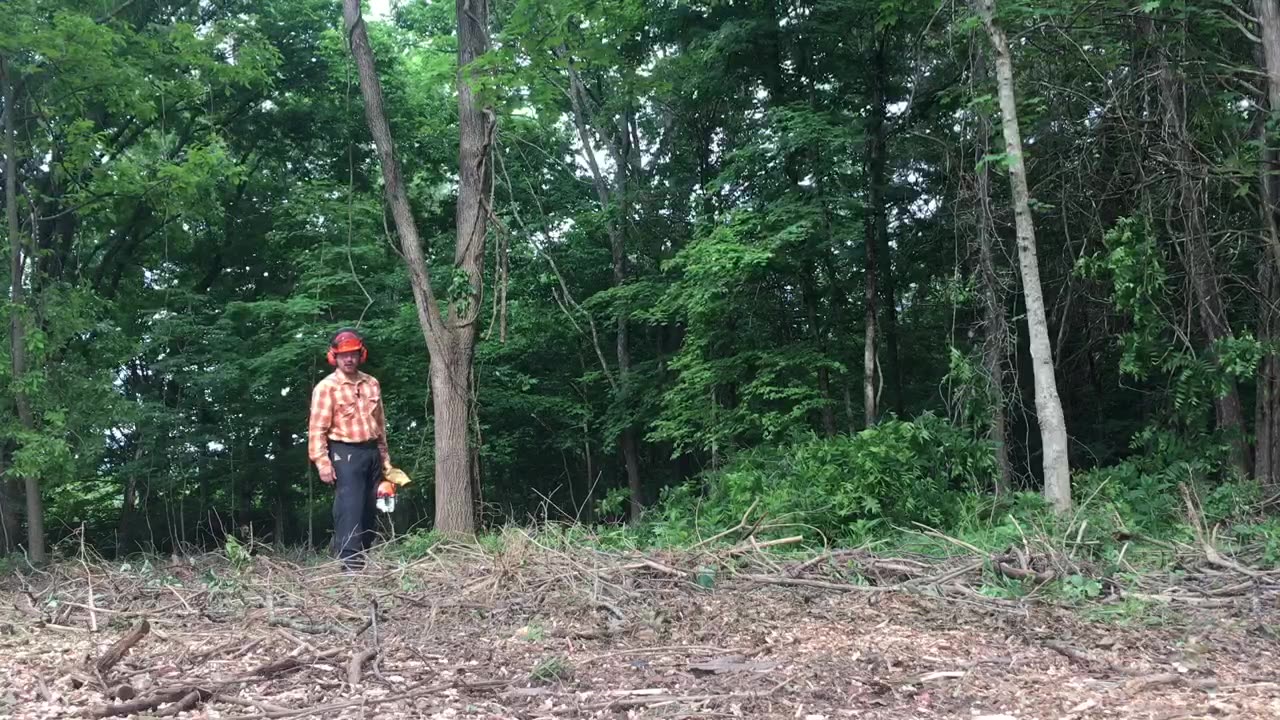Premium Only Content

Northern Kentucky Project: Using Buffer Trees and Walking a Tree Down
This video goes over using buffer trees in directional felling, and how to walk down small to medium sized trees (4"-12" DBH).
The original intro to this video had a user-error for the new mic I was using, so I had to cut out the footage where I explained what I was about to attempt. To summarize, I was showing the placement of the surrounding trees in relation to the targeted felled tree. By planning which trees to cut first, and which to save for later, you can sometimes use another cull tree to protect the trees you are hoping to leave undamaged. By considering the layout of trees which are meant to go, and trees meant to stay, you can use use the walking down method in directional felling.
Some things to keep in mind. Any time you are making cuts on a tree above ground level there is an increased risk of the tree trunk coming down on your leg or foot if not careful, and the closer together the trees are to each other, the greater the risk of the tree top coming back towards you should you walk the trunk to far. Another reason I suggest not using this method for trees over 12" is because the larger the trunk the greater the danger, and the harder it is to get the trunk to fall in a controlled manner. I highly suggest not using this technique until you have had many hours of tree cutting under your belt so you start understanding how trees tend to react to different cuts and weight distributions. I also suggest practicing this technique on smaller trees before moving up to larger ones.
When I describe the cuts used in this method, remember that the "face" of the notch cut goes on the opposite side of the direction you are trying to walk the tree, and the "backcut" goes on the side facing the direction that you want the tree trunk to travel. If you come to a particularly stubborn tree that doesn't want to fall when doing the back cut, and you can't cut anymore without risking it falling to quickly, you can cut a nearby branch at a length that you can push on the cut truck at a safe distance to avoid having a tree falling on your foot.
You may also notice that I am constantly looking around at not only the canopy of the tree I am felling, but also at near by canopies, it is because whenever a tree comes down there may be near by widowmakers that may come down, vines that I may have missed that can interfere with the safe felling of a tree, or other dangers that may come into play during the process. Also, I usually pause between cuts to re-evaluate the tree because there may be weigh-shifts that happen after the initial stop, which can cause the tree to start coming down as you are about to walk up upon it.
-
 LIVE
LIVE
Red Pill News
3 hours agoELECTION DAY 2024 - America’s Future Begins Now on Red Pill News Live
7,951 watching -
 LIVE
LIVE
John Burk
3 hours agoELECTION DAY COVERAGE LIVE!
2,465 watching -
 LIVE
LIVE
PudgeTV
2 hours ago🟡 Practical Pudge Ep 46 | Election Night Special | The State of the Election
765 watching -
 LIVE
LIVE
Matt Kim
3 hours agoElection Day Hangout
2,192 watching -
 LIVE
LIVE
TheDailyWire
5 hours agoElection Night 2024 with The Daily Wire
8,596 watching -
 2:00:59
2:00:59
Human Events Daily with Jack Posobiec
4 hours agoHUMAN EVENTS DAILY WITH JACK POSOBIEC
113K7 -
 1:02:22
1:02:22
In The Litter Box w/ Jewels & Catturd
1 day agoDEFEAT THE CHEAT: VOTE! | In the Litter Box w/ Jewels & Catturd – Ep. 684 – 11/5/2024
119K14 -
 1:23:48
1:23:48
Awaken With JP
3 hours agoElection Day Special LIVE UPDATE - LIES ep 64
157K104 -
 2:04:52
2:04:52
The Quartering
6 hours agoElection Day Madness Already! Voting Machines Breaking, Massive Lines & Scary Numbers For Kamala
201K41 -
 LIVE
LIVE
Badlands Media
1 day agoBadlands Media Special Coverage - The 2024 Election
27,166 watching